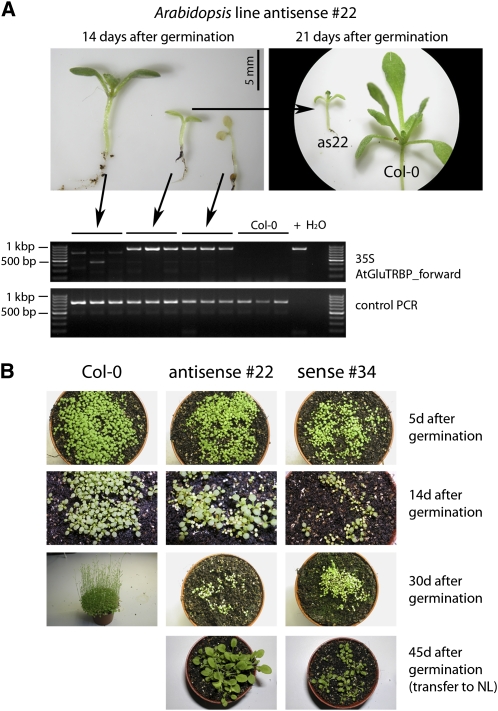Figure 5.
High-Light Stress Phenotype of Arabidopsis Mutants with Reduced GluTRBP Contents.
(A) Phenotype of line AtGluTRBP_antisense_#22 grown under high-light (300 μmol photons m−2 s−1) conditions (line AtGluTRBP_sense_#34 shows a similar phenotype). Besides a segregating wild-type (left in the left panel), two additional phenotypes were distinguishable among the T3 progenies of the transgenic lines. A strong phenotype results in plant death (right plant), and an intermediate phenotype causes growth retardation (medium in the left panel and left in the right panel). Both transgenic phenotypes are connected to the expression of the GluTRBP transgene, as shown by PCR of genomic DNA from three individual seedlings of each of the three different phenotypes (wild-type-like, intermediate or strong) upon stress (indicated by arrows). +, The diluted binary plasmid applied to Arabidopsis transformation was used as positive control PCR template; H20, water as template was used as negative control. Control PCRs using primers to amplify GUN4 were performed to demonstrate the quality of the template DNA.
(B) Phenotype of the lines AtGluTRBP_antisense_#22 and AtGluTRBP_sense_#34 5, 14, 30, and 45 d after germination under high-light conditions. Individual seedlings among the mutant progenies that grew phenotypically like the wild type were removed. When light intensity was lowered to 90 μmol photons m−2 s−1 (NL), 30 d after germination recovery of the growth retardation phenotype of the mutant was observed. The remaining seedlings showed the mutant phenotype, and the presence of the transgene was confirmed by PCR.

